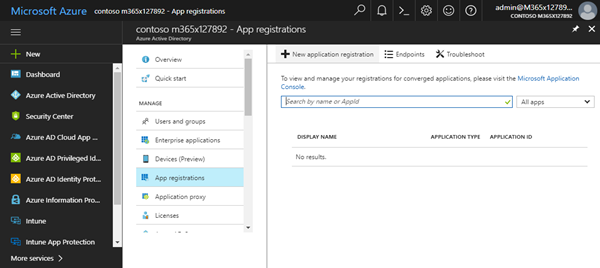
- Setup azure app for office 365 password#
- Setup azure app for office 365 Offline#
- Setup azure app for office 365 windows#
This command imports the session just created into the local session and so here I will see the various cmdlets available to be imported into my session Now run the following command: Import-PSSession $Session.Office 365 PowerShell via the $Session variable Next run the following command: $Session = New-PSSession -ConfigurationName Microsoft.Exchange -ConnectionUri -Credential $cred -Authentication Basic –AllowRedirection.
Setup azure app for office 365 password#
Setup azure app for office 365 Offline#
Usage rights are attached to the message itself so that protection occurs online and offline and inside and outside of your organization’s firewall. Is applied to email by applying an AD RMS rights policy template to an email message.
Setup azure app for office 365 windows#
Information Rights Management (IRM) in Exchange Online uses Active Directory Rights Management Services (AD RMS), an information protection technology in Windows Server 2008 and later and Microsoft Azure Rights Management service in Office 365. For step-by step procedures, seeĬonfigure IRM to use Microsoft Azure Rights Management.Ĭonfigure IRM to use Azure Rights Management

If you’re using Exchange Server 2013, you’ll be able to access Office 365 Message Encryption, too, either by usingĮxchange Online Protection (EOP) or by using hybrid mail-flow.


To Office 365 E3, Office 365 E4, or Windows Azure Rights Management will begin to see the Message Encryption service ready to go. If you are licenced for one of these plans, you will automiatcally have access to office 365 Message Encryption. Windows Azure Right Management is already included with Office 365 E3 and E4 licences. To start using the message service today, you need to purchase a subscription for Windows Azure Right Management (RMS), which also includes Information Right Management capabilites, giving you a comprehensive solutions to help protect your internal and externalĬommunications. The following diagram summarizes the passage of an email message through the encryption and decryption process. The recipient can choose to view the message by signing in with a Microsoft account or a work account associated with Office 365, or by using a one-time passcode.īoth options help ensure that only the intended recipient can view the encrypted message.

The embedded instructions to view the encrypted message on the Office 365 Message Encryption portal. The recipient opens the HTML attachment in the email message, recognizes a familiar brand if that’s present, and follows When a user sends an email message in Exchange Online that matches an encryption rule, the message is sent out with an HTML attachment. A rule can require the encryption of all messages addressed to a specific recipient, for example. With Azure RMS set up for an organization, administrators can enable message encryption by defining transport rules that determine the conditionsįor encryption. Office 365 Message Encryption is an online service that’s built on Microsoft Azure Rights Management (Azure RMS).


 0 kommentar(er)
0 kommentar(er)
